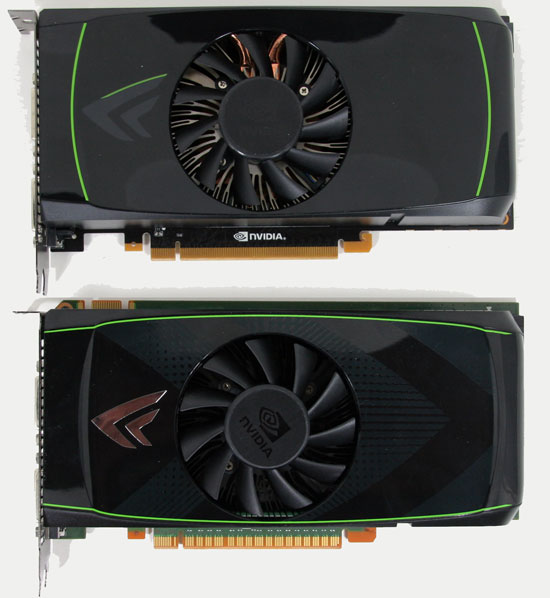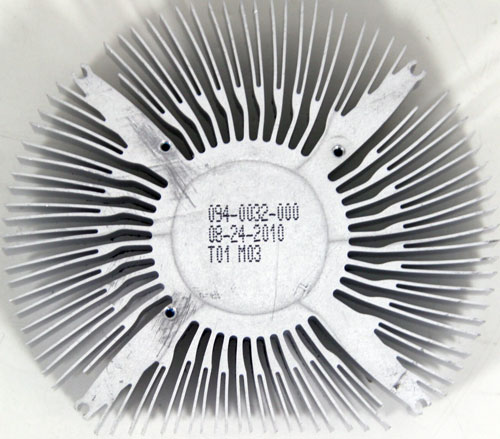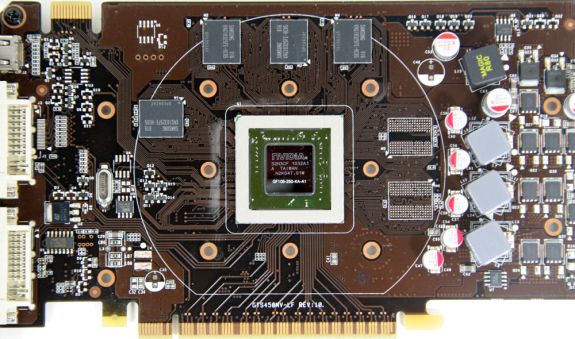NVIDIA’s GeForce GTS 450: Pushing Fermi In To The Mainstream
by Ryan Smith on September 13, 2010 12:02 AM EST- Posted in
- NVIDIA
- Fermi
- GeForce GTS 450
- GF106
- GPUs
Meet the GTS 450
The reference GTS 450 takes a number of cues from the GTX 460, and without labeling on the card it’s actually quite easy to confuse with its bigger sibling. Top-side it uses the same concave shroud and partially-raised fan setup at the GTX 460, and only when you remove these cooling components do you find a simpler circular all-aluminum heatsink between the fan and the GF106 GPU.

Top: GTX 460. Bottom: GTS 450
Since this uses the same cooler design as the GTX 460, it has the same properties: it’s not a fully-exhausting design. The cooler on the reference GTS 450 exhausts towards both the front and the rear of the case, so some degree of case cooling is important. At only 106W TDP this shouldn’t be much of an issue, but there needs to be some airflow within the case.

Meanwhile the PCB and resulting card measure 8.25” long, the same as the GTX 460. This coincidentally is the same length as the reference Radeon HD 5770. The PCB houses pads for 12 GDDR5 memory chips with 6 pads on each the front and back, highlighting the fact that this card isn’t using a full GF106 GPU. With only a 106W TDP, only a single 6-pin PCIe power socket is required to power the card. As with the GTX 460, this socket is rear-facing.
The PCB itself is fairly unremarkable. As is the case with cheaper cards the components are a bit cheaper – you can see a ring-choke near the PCIe power socket. With the card’s fairly low TDP the MOSFETs serving as part of the VRM setup do not require any cooling with the breeze from the fan being enough to cool them at default voltages. The card comes equipped with 8 Samsung GDDR5 memory chips, rated for 4GHz operation. This means there’s a bit of headroom for RAM overclocking if the memory controller is willing to cooperate.

GTS 450 Reference Design PCB (EVGA)

The port configuration remains unchanged from the rest of the 400 series: 2 DVI ports and a mini-HDMI port. The GF106 GPU can only drive 2 displays just like the rest of the Fermi family, so for output options pick any 2 ports. Like the rest of the 400 series, the GTS 400 series is also surround vision capable, so if you have a second card you can SLI them together to gain an additional display output for triple-monitor usage. As this is a lower-end product 3D Vision Surround is not supported due to the lack of performance, but NVIDIA Surround (2D) is supported.

Finally, as was the case with the GTX 460 launch, a number of partners will be launching their own designs today, which we are covering in our companion article that focuses on them. All of these cards are using the NVIDIA reference design or what appears to be a minor variation of it; the big difference on the hardware side of things is the cooler used and bracing methods.










66 Comments
View All Comments
kallogan - Monday, September 13, 2010 - link
"Furthermore our pre-release version of Badaboom with Fermi support doesn’t work either, so that also was dropped"I knew you had a special version of badaboom for your GTX 400s reviews ;)
tviceman - Monday, September 13, 2010 - link
Great job on the article. Well written, well informed. But man, you guys really need to update your benchmark suite. I think Wolfenstein sold maybe about a two dozen copies on PC. Metro2033 now has an excellent built-in benchmark buried within it's directories. L4D2 is a more demanding, and more played game, than L4D1.Since we're entering the DX11 era, incorporating as many DX11 games as possible would make sense.
Taft12 - Monday, September 13, 2010 - link
Agreed, there are a number of titles that even low-end cards can play comfortably. Consider those "case closed"Ryan said the benchmark selections are being updated in the fall, so bring on the SC2!!!
juampavalverde - Monday, September 13, 2010 - link
240mm2 for this kind of performance and power consumption? laaaaameGoty - Monday, September 13, 2010 - link
So they STILL have yet to release a full Fermi-derived chip? How long has it been, now? That's just sad.loeakaodas - Monday, September 13, 2010 - link
Did AMD release a new card or is that a mistype?"Cheese Slices: Radeon HD 5760 Deinterlacing" on the 3rd page.
Etern205 - Monday, September 13, 2010 - link
In the article, the 3-4 paragraph (quote)"entering the world as a 192 CUDA core part but with 3 sets of memory controllers and ROPs, for a combined total of a 192bit memory bus,..."
It was mentioned the card has a 192bit memory bus, but on the chart it says it's has 192 CUDA cores with a 128bit memory bus. So which is correct?
Etern205 - Monday, September 13, 2010 - link
nevermind :)Conficio - Monday, September 13, 2010 - link
Cheese Slices: Radeon HD 5760 Deinterlacingvs
When compared to the Radeon HD 5670, the GTS
thedeffox - Monday, September 13, 2010 - link
Over twenty different configurations, and you didn't include the card it's supposed to replace? Really?It seems a rather obvious card to include. More relevant than cards far outside its price bracket.